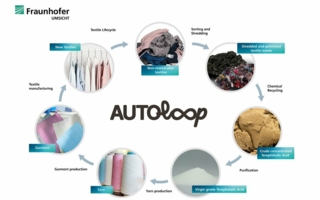25/08/2022 – Recycling
Manufacturers turn to mono material fabrics
As pressure mounts to improve the recyclability of textile products textile manufacturers turn to mono material fabrics and cellulosic fibres.
Developments in advanced mono material fabrics and fabrics made using cellulosic fibres were widespread at the European fabric fairs for spring/summer 2023 as manufacturers continue to improve the recyclability of textile products, according to “Survey of the European fabric fairs for spring/summer 2023” – a 24-page report from the global business information company Textiles Intelligence.
The pressure on companies is increasing
The textile and apparel industry is facing mounting pressures to improve the recyclability of its products in order to move towards a circular economy, and these pressures are being exacerbated by the introduction of new EU laws. In particular, regulations relating to Extended Producer Responsibility (EPR) will come into force in the 27 EU member states from December 2024 and will require manufacturers to take on significant responsibility for the treatment or disposal of post-consumer products.
The recyclability of textile products is problematic because, generally, conventional fabrics and textile products are made using complex mixtures of fibres, dyes and finishing chemicals. As a result, they are difficult to recycle at the ends of their useful lives. Existing recycling plants are unable to work with complex mixtures. Consequently, 73% of apparel ends up in landfill or is incinerated at the end of its useful life. And only 1% of textiles are recycled into new fabrics.
Mono material fabrics are easily recyclable
The difficulties of recycling apparel containing mixtures of fibres are compounded by the rise in popularity of stretch in garments as this has led to the growing inclusion of elastane fibres. Generally, the percentages are small but just 1% of elastane in an otherwise all-cotton T-shirt is sufficient for the garment to be rejected at a recycling sorting plant.
Mono material fabrics, by contrast, are easily recyclable at the ends of their useful lives because they are made entirely from a single type of fibre. But it has been difficult to achieve the levels of comfort, function, style and performance expected by consumers in mono material fabrics.
Developments in mono material fabrics have relied solely on polyester to provide performance attributes. But this is contentious – not least because the bulk of the world’s polyester is derived from petroleum and can not, therefore, be considered to be environmentally sustainable.
Development of advanced mono material fabrics
At the European fabric fairs for spring/summer 2023, some exhibitors had overcome the challenges of developing mono material fabrics and showcased innovations in advanced mono material fabrics which offer environmental sustainability and high levels of performance.
Sanko Textile, for example, showcased a collection of 100% organic cotton fabrics which are biodegradable, compostable and easily recyclable at the ends of their useful lives. The fabrics are lightweight, smooth and soft, and they boast excellent colour brilliance which is maintained, even after repeated wash cycles. The colour brilliance results from using mercerised yarns with a high twist construction in the fabrics.
In order to optimise the recyclability of textile products, some exhibitors had developed fabrics made using cellulosic fibres rather than developing mono material fabrics. Recent advancements in recycling technology mean that cellulose can be recovered easily from cellulosic fibre textile waste and used in the manufacture of pulp for producing new fibres.
At the European fabric fairs, Bossa, a company based in Adana, Turkey, presented a denim fabric collection which it had produced using blends of cellulosic fibres in the form of cotton, lyocell, Naia and Refibra fibre. Unlike conventional mono material fabrics, fabrics in the Bossa denim fabric collection provide a range of performance properties as a result of the different types of cellulosic fibre used in their manufacture. In particular, Naia fibre imparts quick drying properties, softness and a high level of comfort while Refibra fibre facilitates a high level of moisture absorption.
Tosco, a fabric manufacturer based in Tokyo, Japan, showcased shirting fabrics made using cellulosic fibres in the form of cotton, lyocell and modal in blends with ramie – a lesser known cellulosic bast fibre.
- The “Survey of the European fabric fairs for spring/summer 2023” is available for purchase from Textiles Intelligence. For further information or to purchase this report, visit https://bit.ly/3bpZBWu.




